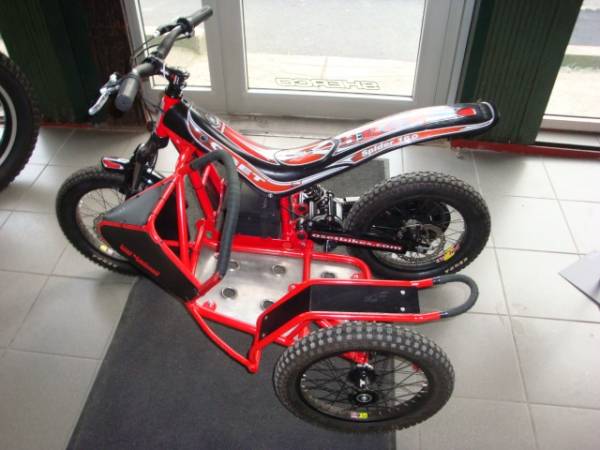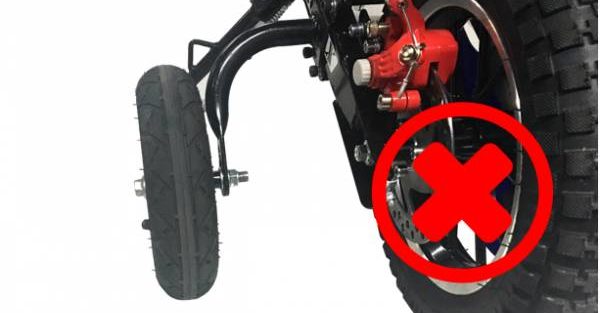I remember the feeling!
You got a 12.5 ”OSET or similar small Trial motorcycle in the workshop, and you just want to get Junior to ride it. It is so tempting to put training wheels on the motorcycle to get them riding. But resist the temptation, because in my opinion it’s the wrong way to get them started – even though you are aching for them to start riding.
Why not training wheels?
Let me be frank. Although I am not in favor of training wheels – both on motorcycles and bicycles – I do not judge anyone for using them. When I was a kid, I learned to ride a bike by having my dad put training wheels on my bike, and it haven’t stopped me from riding bikes and motorcycles today.
You can learn to ride a motorcycle with training wheels on the bike – but it doesn’t help the rider, and more often it will set them back.
For new riders to learn how to ride a motorcycle, there are basically 3 things they need to know. Balance, Steering, Gas and Brake. Of these 3 things, the easiest is gas and brake, whereas steering and balance take a little more energy and effort for most.
Training wheels don’t teach balance.
For most kids, balance is the hardest of the 3 basic things. When you attach training wheels to the motorcycle (or bike), the child will automatically use the training wheels to keep balance.
In this way, the child only learns how to keep the balance very slowly.
To put it simply – if the child must learn how to keep the balance on 2 wheels – then it must also be on 2 and not 4 wheels.
Training wheels are inferior for practice steering.
Of course, balance and control are closely related.
Since a motorcycle with training wheels does not balance like a real motorcycle, it also requires the child to steer differently and give different steering input, than would be the case if there were no training wheels.
Here I would normally give a long and detailed instruction on how the gyroscopic effect of the wheel works, but I will not do that. Instead I will point out that an important part of steering a motorcycle is that the child learns to lean the bike to make it turn. This does not apply to a motorcycle with training wheels.
Gas and brake can be learned with training wheels.
Giving gas and being able to slow down is of course essential on a motorcycle.
I have chosen to put these together as one, because most children start on a 12.5” motorcycle – e.g. OSET 12.5”. In the case of small motorcycles, most children will brake solely by shutting of the gas, and thus to a lesser extent applying the brake.
Furthermore, many kids will still use their feet to slow down at first. Something that only really change, when they get to stand up on the motorcycle.
However, my experience is that it is relatively easy to teach a child to operate the throttle.

Training wheels have unnecessary safety issues!
Let’s face it – you can’t ride a motorcycle without you sometimes crashing – but we must always try to minimize the risk.
As described under the section about steering, the rider can’t make the body lean when turning, if training wheels are mounted on the motorcycle.
If the child is unable to lean the motorcycle into the turn, the centrifugal force will try to push the child opposite the turn direction. In short, the motorcycle automatically tries to throw the rider of the bike.
This can result in some serious crashes where the rider gets a so called “high-side” crash.
A high-side crash is characterized by the rider being pushed up and over the bike and is therefore often more severe than a “low-side” crash.
The child will also experience more “near miss” situations, as they will experience times where there is no contact between the rear wheel and the ground when turning.
As described above, a large part of the braking effect on a 12.5 or even a 16” motorcycle is defined by how much gas the child apply (or stops applying). With that in mind, it’s problematic that the rear wheel does not have ground contact in some turns, in effect makes the rider experience a lack of control.
So, what should I do?
I would always advise that you start by gaining control of balance and control. This is best done on a pushbike.
We started taking our son to Trial training on a small pushbike when he was about 2 years. When he showed complete control on balance and steering, he progressed onto a 12.5” motorcycle.
You have my guarantee. Don’t get training wheels, and instead focus on the basics on a pushbike. This will be the better choice in the long run and will get your little rider to progress faster.
Enjoy this moment, because before you know it, they will be racing away from you.




 Zone training with Trial
Zone training with Trial
